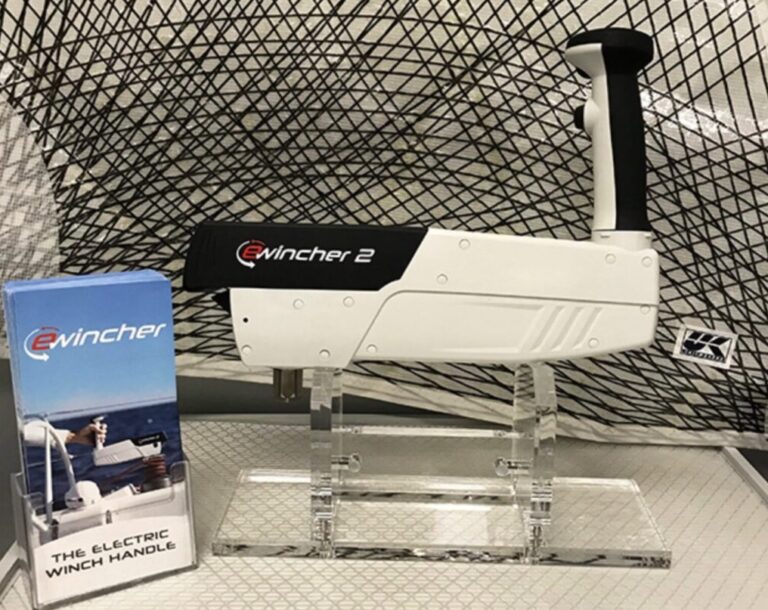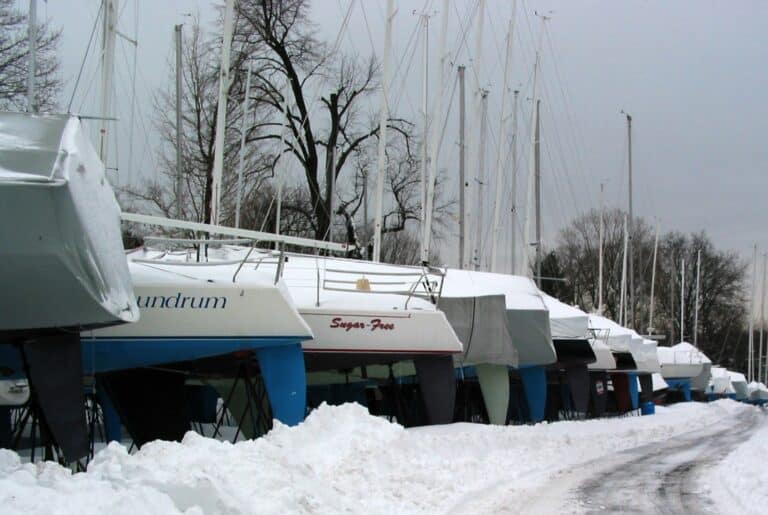Sailors in the Northern Hemisphere are entering autumn, marking the tail end of their active sailing season. For some, November and December are the time to haul their boats for winter; for most, it means a slowdown from peak sailing season. There is no better time to take a close inspection of your sail inventory to ensure it’s in shipshape for Spring! Your local UK Sailmakers loft will be happy to assess your sails for any needed maintenance or cleaning. There’s also no better time to order a new sail for Spring delivery.
Here are some tips to help you inspect your own sails before bringing them into the loft:
1. Examine Your Inventory
Take a look at all the sails in your inventory. Note the condition of each sail and any gaps in your sail plan. This will help you decide the most critical sails for repair or replacement this season and create a plan for years ahead to suit your needs, budget, and goals.

An assortment of gold UK Sailmakers sail bags.
2. Record Your Sails
Before you wrap up your sailing season, now is the time to take photos or videos of your sails in action. Use the right sail for the conditions and ensure it is trimmed correctly. Upwind sails should be documented sailing close-hauled. These year-to-year records will help you track any changes to your sail’s shape over time.
- Photographs should be taken from mid-foot, upwards, towards the head of the sail.
- Ensure images are high quality for the best results; a DSLR camera with a wide-angle lens is the best bet, but even today’s modern smartphones are up to the task.
- Include all draft-stripes in the image.
- Note the conditions, rig tuning, and sail controls for a comprehensive record.

Programs such as UK Sailmakers’ AccuMeasure can help analyze a sail’s shape from digital photographs. Learn more here: https://www.uksailmakers.com/how-to-resources/accumeasure
3. Take Measurements
Record your sail measurements for each new sail, and re-measure at the end of each season. The most critical measurements depend on the type of sail and the rating system you sail under (PHRF, IRC, ORC, etc.). Check with your sailmaker if you need any clarification, but at a minimum, this includes the luff, leech, and foot of each sail. Store these measurements in a safe and easily accessible place for future reference; this is another way to track any changes to your sail over time.
4. Note Wear and Tear
All sails will experience some wear and tear over their lifetime; it’s important to assess your sails each season for damage. The old adage, “a stitch in time saves nine,” is especially true for UV covers. Your local UK Sailmakers loft will be able to quickly identify any recommended maintenance for your sails that will help prevent costly repairs or sail failures in the future. Having your sails repaired and serviced by a professional at your local UK Sailmakers loft will ensure that you get the most out of your sails. Some key points to examine include:
- Stitching at seams and reinforcements and wear on edge tapes and handwork, including luff and reef hardware and corner webbings.
- Chafe points from mast hardware, stanchions, shrouds, or spreaders (including positions when reefed) that should be reinforced.
- UV damage to a UV cover where applicable and to the sail itself.

The pencil led test is a classic test of stitch integrity; a sharpened #2 pencil lead should break before the thread. Broken thread could be an indicator of poor thread quality or damage from abrasion or UV exposure.
5. Identify Necessary Sail Repairs, Modifications, or Cleaning
Whether Tip 4 was a DIY effort, or a professional loft assessment, the next step is determining which repairs, modifications, or cleaning should be done before next season. Remember that prevention is key, and delayed maintenance this season can lead to a more costly repair bill next season. A simple sail re-sew can turn into a new sail quote with one particularly nasty winter storm.
Sails that are past their prime can often be modified to extend their useful lifespan. Roller-furling headsails in good condition can have their UV covers replaced or repaired. Soiled sails appear much newer with professional cleaning. Sails that are losing their shape can be recut, and tired leeches reinforced. Delaying these repairs may see your sails into early retirement, which is bad for the wallet and the environment.

Side-by-side comparison of a sail with extensive pest damage (right) and its brand-new counterpart made at the UK Sailmakers Northwest loft (left).
6. Practice Good Sail Storage
If you do live in a region where boats are hauled out for the winter months or see little use during that time, consider removing your sails from your boat and storing them in a controlled environment. Some UK Sailmakers lofts offer sail storage for a reasonable fee.
Sails that need to be stored for any length of time need to be clean and dry before they are bagged. Pests, moisture, poor air circulation, and extreme temperature swings can all cause damage to a sail in storage.
- Moisture increases the risk of mildew growth and staining, which can be difficult to remove, even with professional cleaning. Sails stored on a furler, exposed to the elements for long periods of time, are particularly susceptible to this type of damage.
- Pests, including rodents and bugs, can make homes in rolled or flaked sails. This is especially common in mainsails left on the boom in bags or lazy cradles over winter, but can also occur in bagged sails in storage. Pests chew holes in sailcloth to create their homes and leave behind unsightly waste.
- Extreme heat and cold can pose a risk for laminate and woven sails; we recommend a storage spot that is cool to room temp, dry, and well-ventilated. Extreme heat can cause sails to delaminate, change shape, or become brittle. Extreme cold can also cause some materials to lose their flexibility and entice pests to make their home in your sails.
Following the steps listed in this guide will help ensure your sails’ longevity and performance. You can read more about the Care and Protection of Sails on the UK Sailmakers Encyclopedia.





